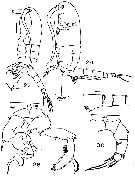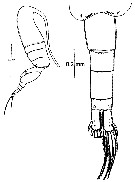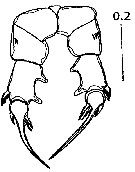|
|
 |
|
Calanoida ( Order ) |
|
|
|
Diaptomoidea ( Superfamily ) |
|
|
|
Pseudodiaptomidae ( Family ) |
|
|
|
Pseudodiaptomus ( Genus ) |
|
|
| |
Pseudodiaptomus malayalus Wellershaus, 1969 (F,M) | |
| | | | | | | Syn.: | Pseudodiaptomus binghami malayalus Wellershaus, 1969 (p.262, figs.F, M); Pillai, 1976 (1980) (p.251, figs.F,M); Madhupratap & Haridas, 1986 (p.105, tab.2); Ramaiah & Nair, 1997 (tab.1); Achuthankutty & al., 1998 (p.1, Table 2, seasonal abundance vs monsoon); Madhu & al., 2007 (p.54, Table 4, abundance vs monsoon) | | | | Ref.: | | | Ranga Reddy & Radhakrishna, 1982 (p.261: Rem.); Santu K.S. & al., 2017 (p.3, figs.F, M, Rem.: genetic analysis) |  Issued from : S. Wellershaus in Veröff. Inst. Meeresforsch. Bremerh., 1969, 11 (2). [p.260, Fig.27-30]. As Pseudodiaptomus binghami malayus subsp. Female (from (Cochin Backwater, India): 29, habitus (lateral; with detail of thoracic segment 5 edge); 30, P5. Nota: - Ratio cephalothorax : urosome = 1.5. - Proportions of the abdominal segments 32, 18, 22, 11; right caudal ramus 17 (20 %). Caudal ramus length 17, breadth 7 (The different lengths of the caudal rami may be an artefact: Length: breadth = 2.5 right; 2.4 left). Male: - 27, habitus (lateral; with detail of thoracic segment 5 edge); 28, P5. Nota: Proportions of the urosomal segments 13, 18, 19, 21, 11; right and left caudal rami = 18 %. - Caudal ramus length : breadth = 2,7. Rem: The present form differs from P. binghami Sewell by different aspects: The female P5 has one terminal spine less, and the proportions of the spines are different; the female caudal rami proportions are slightly different; the female abdomen bears another pattern of spinulation dorsally; Tthe thoracic segment 5 bears some spinules ventro-laterally in both sexes; the male P5 differs in having an additional projection on the long projection of the left basipod 2, and there is a long broad spine on exopod segments 2-3.
Scale : single line = 0.1 mm ; double line = 0.05 mm.
|
 Issued from : K.S. Santu, S. Bijoy Nandan, R.I. Cleetus & M. Harikrishnan in Mitochondrial DNA Part A, 2017. [p.4, Figs. 2, 3]. Female (from 9°40'-10°12'N, 76°10'-76°30'E); fig.3, habirus (right lateral view); fig.4, urosome (dorsal view). Nota: - Prosome : urosome ratio 61 : 39. - Prosome 1.26 times longer as broad (1.9 : 1.5). ) Head imperfectly fused with 1st pediger segment, 4thj and 5th thoracic segments also imperfectly fused. - Rostrum with 2 filaments, these shorter than the 1st segment of A1. - Posterolateral corners of prosome rounded with small dorsal spine on each side above urosome insertion and, below this, vertical row of about 10 small spinules. - Urosme 4-segmented; proportional lengths of urosomites plus caudal rami 36 : 14 : 21 : 12 : 17 = 100. - Genital segment prijecting symmetrically with somewhat long tuft of fine hairs on ventral side and containing receptaculum seminis; some bears pair of egg sacs. - Urosomite 1 interrupted in the middle by 9 large spinules, 8 spinules on either side. - Posterior margin of urosomite 2 incomplete laterally, with 16 large, coarse teeth mid-dorsally, these diminishing in size ventrolaterally. - Urosomite 3 complete with 16-18 more or less transverse rows of coarse teeth mid-dorsally, their size lessening laterally. - Urosomite 4 furnished with spinules posterolaterally and scattered ornamentation anterolaterally, but barren mid-dorsally. - Caudal rami symmetrical, divergent and slightly over 1.6 times as long as broad (1.8 : 1.1); dorsal side of each ramus with 2 pairs of irregularly arranged cluster of spinules (abour 11-16 coarse spinules each); inner matgons kairy; each caudal ramus except outer seta 1 with 5 strong unjoined, dagger-shaped setae, outer seta 3 being strongest (dilated and spearhead-shaped), folloxed by outer seta 2; in addition 1 small sensory bristhe lying between outer seta 4 and 5; length-wodth ratio of caudal ramus and length ratio of setae (counted from outside) in Table 1 - A1 21-segmented, reaching almost to posterior margin of genital segment; incomplete articulation separating segments 6 and 7; - Mouth parts alike for all pseudodiaptomid species. - Armature formula of P1-P4 in Table 2.
|
 Issued from : K.S. Santu, S. Bijoy Nandan, R.I. Cleetus & M. Harikrishnan in Mitochondrial DNA Part A, 2017. [p.5, Fig.4]. Female: P5 (dorsal view). Scale bar in mm. Nota: - Left and right legs identical, uniramous, 4-segmented; basis slightly broader than coxa, without ledge on inner margin and with a few spinules on distal outer region; exopodal segment 1 cylindrical and longer than the basis and coxa bearing 1 strong, internally serrate spine at distal outer angle; 2 short, blunt, spinous processes, each with a hyaline lobe, at its proximal and distal internal angles; a row of a few spinules on distal external margin just behind above mentioned serrate spine; exopodal segment 2 bearing 4 strong, serrate spines, of which 3 short and remaining one longer than the combined length of basis and exopodal segment 1.
|
 Issued from : K.S. Santu, S. Bijoy Nandan, R.I. Cleetus & M. Harikrishnan in Mitochondrial DNA Part A, 2017. [p.4, Table 1]. Female: The length-width proportions of the caudal ramus and setae of P. malayus
|
 Issued from : K.S. Santu, S. Bijoy Nandan, R.I. Cleetus & M. Harikrishnan in Mitochondrial DNA Part A, 2017. [p.4, Table 2]. Female: Armature formula of the swimming legs P1 to P4 of P. malayus..
|
 Issued from : K.S. Santu, S. Bijoy Nandan, R.I. Cleetus & M. Harikrishnan in Mitochondrial DNA Part A, 2017. [p.5, Figs. 6, 7]. Male: fig.6, habitus (left lateral view); 7, urosome (lateral view). Nota: - Prosome : urosome ratio 61 ; 39. - Prosome 1.8 times longer than wide (1.7 : 0.9). - Pedigerous segment 5 bearing spine similar to that in female; spines scattered and fewer in number. - Proportional lengths of urosomal segments and caudal rami 11 : 22 : 21 ; 21 ; 8 : 17 : 100. - Urosomal segment 1 with few spines only on dorsal posterior margin; - Urosomal segments, 2, 3 and 4 armed with spines on posterior margin. - Caudal rami devoid of spines; setae less strong and more normal than those of female.
|
 Issued from : K.S. Santu, S. Bijoy Nandan, R.I. Cleetus & M. Harikrishnan in Mitochondrial DNA Part A, 2017. [p.6, Fig.8]. Male: P5 (dorsal view). Scale bar in mm. Nota: - Basis of left P5 with long projection on inner side, this bearing another small projection on its side; spine on left exopodal segments 2-3 much longer than in female
|
 Issued from : K.S. Santu, S. Bijoy Nandan, R.I. Cleetus & M. Harikrishnan in Mitochondrial DNA Part A, 2017. [p.8, Table 3]. Morphological characteristics of female specimen of P. malayalus with previous record of P. malayalus and P. binghami. (specimen from Nambur canal, Andhra Pradesh, India).
|
 Issued from : S. Wellershaus in Veröff. Inst. Meeresforsch. Bremerh., 1969, 11 (2). [p.262]. As Pseudodiaptomus binghami malayalus. Female (from Cochin Backwater): Propotions of the abdominal segments and caudal and caudal setae
|
 Issued from : S. Wellershaus in Veröff. Inst. Meeresforsch. Bremerh., 1969, 11 (2). [p.262]. As Pseudodiaptomus binghami malayalus. Male (from Cochin Backwater): Proportions of the abdominal segments
| | | | | NZ: | 1 | | |
|
Distribution map of Pseudodiaptomus malayalus by geographical zones
|
| | | | | | | Loc: | | | India, Cochin Backwater, Vembanad estuarine system, Bombay, Kerala, Goa | | | | N: | 8 | | | | Lg.: | | | (1005) F: 1,25-1,30; M: 1,08-1,11; (1211) F: 1-1,27; M: 1,02-1,1; {F: 1,25-1,30; M: 1,02-1,11} | | | | Rem.: | Limnetic, estuary.
Incomplete data.
In Lobus species group (forbesi subgroup) after Walter & al. 2006, p.203.
After Ranga Reddy & Radhakrishna (1982, p.261), the salient features are in the female: the 5th pedigerous segment bears at its distal outer corner about 10 small spines almost in a vertical row; the genital segment is armed with spines only along its posterior border; the exopodite 2 of P5 has 1 terminal spine less. In the male left P5, the 'laminal process' of the basis bears 2 digitiform processes; the shape of exopodite 2 is unique, as is the spine borne by the same segment. All the above characters are so distinct from the typical form that it seems justified to accord full species status to the subspecies from Wellershaus.
The specimen identified by Santu & al. (2017, p.10) is well characterized as P. malayalus like body form, size, the postero-lateral corners of prosome, arrangements of small spinules on posterior margin; spines on the genital segment and pear shaped caudal setae. However, the female of P. malayus exhibited some variations from original illustrations given by Wellershaus (1969) in the number of terminal spines on P5; ornamentation of spinules on exopodal segment 1 of P5 and urosomal segment 4; arrangements of spinules on caudal rami and length width ratio of urosome and caudal rami. The length width ratio of caudal setae; length ratio of urosome and caudal rami slightly different than earlier descriptions. P. malayalus is distinguished from P. binghami by P5 exopodal segment 1provided with 2 hyaline lobes, one at its distal internal angle and other one in middle of internal margin of this segment but there is no second hyaline lobe at the middle of internal margin of this segment in P. binghami. The female P5 of P. malayalus has 1 terminal spine less (even though it possess 4 terminal spine on exopodal segment 2 of female P5 which might be missed by Wellershaus) and the proportions of the spines are different; the female caudal rami ptoportions are slightly different and the female abdomen bears pattern of spinulation dorsally.
Significant and discrete morphological differences are observed between the two Indian species , but the male specimens of P. malayalus do not show any major differences from the original description.
Genetic distance data obtainede from COI sequences revealed 22% interspecific divergence values which confirmes the status of P. malayalus and P. binghami as two distinct species. | | | Last update : 18/12/2017 | |
|
|
 Any use of this site for a publication will be mentioned with the following reference : Any use of this site for a publication will be mentioned with the following reference :
Razouls C., Desreumaux N., Kouwenberg J. and de Bovée F., 2005-2025. - Biodiversity of Marine Planktonic Copepods (morphology, geographical distribution and biological data). Sorbonne University, CNRS. Available at http://copepodes.obs-banyuls.fr/en [Accessed December 03, 2025] © copyright 2005-2025 Sorbonne University, CNRS
|
|
 |
 |








